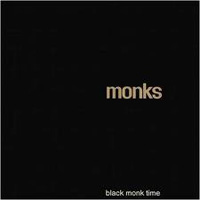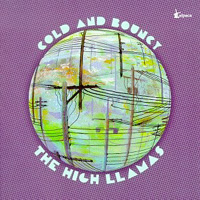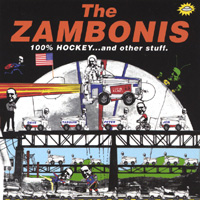 The Monks
The Monks
Black Monk Time (Infinite Zero/American)
by Nik Rainey
The folks at Infinite Zero (the burly, hirsute Slayer fan and the musclebound, caffeine-crazed illustrated man) have performed an invaluable public service with their latest re-ish. Heretofore, they’ve mostly brought records that can be fairly easily found in thrift shops (from Gang of Four and Devo to Alan Watts and Louise Huebner) into the digital age, but with the Monks‘ Black Monk Time, they’ve unearthed a genuine obscure punk artifact, a record (and a band) whose legend has grown steadily over the thirty years since its recording but, until now, has never been available Stateside. This album is one of the buried roots of raw American rock, and the story behind the band itself (which can be perused in its entirety in Gary Burger’s book, Black Monk Time, available from Carson Street Publishing, 205 East John Street, Carson City, NV 89706) is a tale so wonderfully anomalous it could only happen in rock ‘n’ roll.
Briefly: On an army base in Geinhausen, Germany (a small town on the outskirts of Frankfurt) in 1962, five bored G.I.s – Burger, Dave Day, Eddie Shaw, Larry Clark (not the photographer), and Roger Johnston – formed a rock band, the Torquays, to make a few extra pfennigs and just to blow off a little military steam. Like most ad hoc club bands, their repertoire consisted mostly of covers of the hits of the day (Dion, the Beatles, the Stones), but soon enough they began adding original material to their set list and absorbing both the then-popular strains of beat music and the tense reality of their surroundings. “We…said, `We’re tired of playing all this sweet garbage that talks about how pretty you are and how sweet the world is’,” Burger says now. “The world wasn’t a sweet place. Germany itself was a troubled country… we got a lot of our influence there.”
That influence manifested itself in a sparser, more repetitive and tenser approach than other bands were offering at the time (remember, this was 1965), with an eye to grabbing the attention of notoriously fickle club audiences. To that end, they tossed out their cymbals, replaced the rhythm guitar with an electric banjo, and draped their songs in fuzztones and feedback. As radical as the resultant sound was, however, the piece de resistance came when they changed their name to the Monks and altered their image to match. Most mid-sixties bands dressed in matching gear, and the Monks were no different in that respect, except that their uniforms (on and off-stage) consisted of black cowls, immaculately polished shoes, and, for the final, perfect touch, giant bald spots shaved into their heads. Oddly, audiences expecting a cheery quintet running through covers of “Ruby Baby” and “Skinny Minnie” didn’t cotton to this radical revision, and Monks gigs were met with nervous, bewildered audiences (most of whom were too scared to even look at the band) and occasional outright hostility (in Southern Germany, a man jumped on stage and began throttling Burger – and you punks thought gobbing was a hassle). Notoriety has its advantages, however, and their rough-hewn demo tape fell into the hands of German Polydor, who were also taken aback but signed them anyway. (“This stinks – but let’s try it!”) The iron was hot, and the Monks struck – they checked into a Cologne studio and bashed out Black Monk Timein six days. Heard today, it still sounds raw and radical – their sound bears a passing resemblance to the garage punk then being fermented Stateside, but with a crazed character all its own. Berger’s hoarse shout (augmented by shots of straight whiskey) lends an out-of-control tone to his anti-Vietnam, anti-love rants, while the band is almost pure rhythm, the boom-ba-boom of Roger Johnston’s toms matched pound for pound by the tense shot-nerve simplicity of the rest of the band, Larry Clark’s astringent organ providing the only melody to be found. Naturally, American labels were hesitant to say the least – lyrics like “pussy galore’s coming down and we like it” and “Shut up! Don’t cry!” were hardly commercial fare – and BMT never saw the light of day outside of Europe, though it has remained a touchstone for musical non-conformists ever since (like Mark E. Smith of the Fall, who have covered no fewer than three of these songs).
 Something so volatile was born to die a swift death, of course, and following this album, the Monks only lasted long enough to put out two far more conventional-sounding singles (both included on the reissue, along with a live “Monk Chant” and two tracks from their original demo) before splintering off into foot-notoriety. Lucky for us, we can now get a taste of this singular concoction at a reasonable price and luxuriate in the irreplicable proto-punk plunk that is the Monks. So tie those cowls tightly, fix a beautiful scowl on your face and get ready to rumble – it’s Monk time!
Something so volatile was born to die a swift death, of course, and following this album, the Monks only lasted long enough to put out two far more conventional-sounding singles (both included on the reissue, along with a live “Monk Chant” and two tracks from their original demo) before splintering off into foot-notoriety. Lucky for us, we can now get a taste of this singular concoction at a reasonable price and luxuriate in the irreplicable proto-punk plunk that is the Monks. So tie those cowls tightly, fix a beautiful scowl on your face and get ready to rumble – it’s Monk time!



